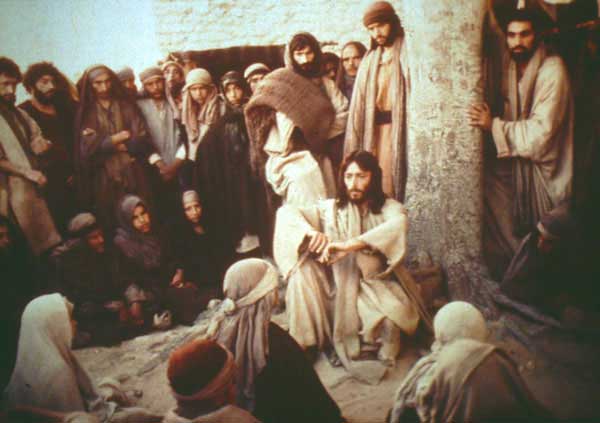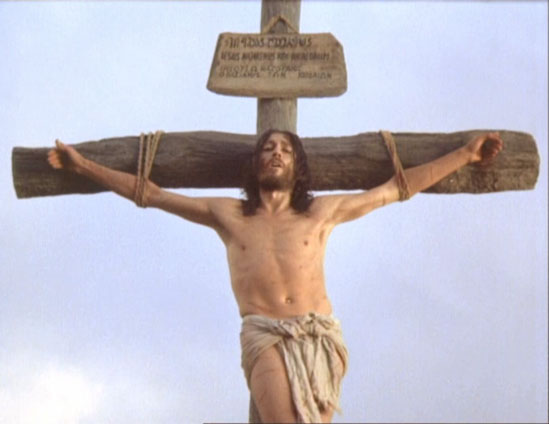John 12:32
“Now judgment is upon this world; now the ruler of this world will be cast out. And I, if I am lifted up from the earth, will draw all men to Myself.”
The drawings of John 6:44 and John 12:32 are dissimilar in that one is a pre-Calvary drawing by the Father for one purpose, and the other is a post-Calvary drawing by the Son for another purpose. The Father’s pre-Calvary drawing was of the faithful remnant of Israel to His Son, whereas the Son’s post-Calvary drawing was evangelical in purpose, for all men, both distributively and indiscriminately.
The part about being “lifted up” references to John 3:14, as it relates to Numbers 21:6-9. Jesus knew that His manner of death would not be by stoning, but by crucifixion.
John 12:31-32: “Now judgment is upon this world; now the ruler of this world will be cast out. And I, if I am lifted up from the earth, will draw all men to Myself.”
John 3:14-15: “As Moses lifted up the serpent in the wilderness, even so must the Son of Man be lifted up; so that whoever believes will in Him have eternal life.”
Numbers 21:9: “And Moses made a bronze serpent and set it on the standard; and it came about, that if a serpent bit any man, when he looked to the bronze serpent, he lived.”
Question: When would Jesus “draw” all men to Himself?
Answer: Post-Calvary. During Jesus’ earthly ministry, the Father had sent Him to only the lost sheep of the house of Israel: “I was sent only to the lost sheep of the house of Israel.” (Matthew 15:24) However, nearing the end of Jesus’ earthly ministry, Jesus mentions a new focus: “I have other sheep, which are not of this fold; I must bring them also, and they will hear My voice; and they will become one flock with one shepherd.” (John 10:16) Post-Calvary, there would be a world-wide mission to include His other sheep, the Gentiles. Jesus states: “Go therefore and make disciples of all the nations, baptizing them in the name of the Father and the Son and the Holy Spirit, teaching them to observe all that I commanded you; and lo, I am with you always, even to the end of the age.” (Matthew 28:19-20)
Question: Why would Jesus “draw” all men to Himself?
Answer: For salvation, since there is a connection that references John 3:14’s illustration of the bronze serpent.
Question: What is Christ’s “draw”?
Answer: The presentation of the Gospel.
Question: How does Christ’s “draw” at John 12:32 compare with the Father’s draw at John 6:44?
Answer: The Father’s pre-Calvary draw at John 6:44 is His drawing of the believing remnant of Israel to His Son. The Son’s post-Calvary draw at John 12:32 reaches out to the rest, namely, a world-wide evangelical mission to both Jews and Gentiles.
Question: Who does “all men” include?
Answer: Everyone indiscriminately. Employing a hostile witness, Calvinist, Charles Spurgeon, answers: “What is the election of a nation but the election of so many units, of so many people? and it is tantamount to the same thing as the particular election of individuals.” (Jacob and Esau, emphasis mine)
If Jesus draw all nations to be saved, then by Spurgeon’s reasoning, it follows that He wants all individuals of those nations to be drawn, because what is a nation but so many units of so many people?, which is tantamount to the same thing as individuals since, what is a nation but the sum of its parts?
Question: Does God “draw” those who’ve never heard the Gospel?
Answer: Deceased infants haven’t heard the Gospel either, so one wouldn’t necessarily say that they were drawn by the Gospel, but the larger point is that the drawing of all men, as per John 12:32, is parallel to the scope of the Gospel reach. Jesus states: “And He said to them, ‘Go into all the world and preach the gospel to all creation.’” (Mark 16:15)
Question: At Matthew 22:14, the ratio is that there are more called than chosen, so the question for the Calvinist is: why shouldn’t we also conclude from John 12:32 that there are also more drawn than those who come? What’s different?
Calvinist, Erwin Lutzer: “Calvinists exhort us to examine the use of the word all as it is used in the Bible to see if it always means each and every individual in the world. For example, when Christ said he would draw all men to himself, it cannot mean each person in the world--indeed the vast majority are not drawn to him but are lost.” (The Doctrines That Divide, p.186, emphasis mine)
The Calvinist attempt here is to equate “draw” with saved. Arminians, however, do not share such an inference. By contrast, the Arminian inference is that John 12:32’s drawing should be understood similarly to Revelation 3:20’s knocking, in terms of the divine initiative in reaching the lost.
Robert Shank: “Our Lord’s words confront us with one of the most solemn questions we ever shall face: what is my response to this gracious drawing of Christ? The initiative in salvation indeed is God’s, implemented in the gracious acts of the Father, the Son, and the Holy Spirit.” (Elect in the Son, p.199, emphasis mine)
This is exactly how Arminians interpret it, but all too often, whenever Calvinists engage a text, they give a very one-sided explanation, so that only the Calvinist bias is given a fair hearing.
John Calvin: “When Christ says, ‘all’ he must be referring to the children of God, who are his flock.” (John: Calvin, The Crossway Classic Commentaries, p.308, emphasis mine)
Arminians reject that, and feel that Calvinists are simply trying to protect their own bias interpretations.
Calvinist, William MacDonald: “But probably the correct explanation is that the crucifixion of the Lord Jesus resulted in all kinds of people being drawn to Him. It does not mean all people without exception, but people from every nation, tribe and language.” (Believer’s Bible Commentary, p.1539, emphasis mine)
Calvinist, James White: “…John 12:32...that passage is patently not teaching any kind of universal drawing of every single individual. The passage is about the coming of Gentiles who are seeking Jesus, so that the ‘all men’ is in reference to Jews and Gentiles, as it most often is in Scripture.” (Debating Calvinism, p.125, emphasis mine)
James White: “Further, it is obvious that the cross of Jesus Christ repels unbelievers. It does not attract them. As Paul taught, the Cross is foolishness and a stumbling block. Hence, the obvious meaning, especially in light of Revelation 5:9, is that the ‘all men’ of John 12:32 refers to those who are of every tribe, tongue, people, and nation.” (Debating Calvinism, p.125, emphasis mine)
The Calvinist attempt here is to equate “draw” with “attract.” Again, Arminians do not share such an inference. The Arminian interpretation is that Christ is speaking of what He would actively do, obviously being through His messengers, the Gospel and the Holy Spirit.
5-Point Calvinists typically utilize the “of the elect” defense, by interpreting the draw as being effecacious for “all men” of the elect, involving Irresistible Grace.
4-Point Calvinists typically view the draw as being for “all men” indiscriminately, in agreement with the Arminians.
However, some Calvinists suppose that the draw is not for salvation all, but for the elect, it is a draw to be raised up for eternal life, while for the non-elect, it is a draw to be raised up for eternal death.
If John 12:32 is indeed a parallel to John 3:14, which it appears to be, then the answer becomes clear. For even if everyone in Israel didn’t look upon the bronze serpent and live, everyone was forced to make a decision concerning it, whether to look upon it, or to refuse it, and that appears to be true concerning the Cross. The reality of sin, means that people have to contemplate it. Whether they look to Christ or reject Him, all are nonetheless drawn to Christ by being put to a decision concerning Him.
One member of The Society of Evangelical Arminians: “People are not Turing machines and neither are they are automatons. They were created in the image of their maker and given a will. Fallen and apart from grace, their will is under bondage and may only select from the many evils. Yet God doesn’t leave people that way. He pours his Spirit out upon all flesh and gives all people grace that frees their will from the total bondage of sin so that they can begin to move step by step closer to God by choosing the good over the evil. And though men love darkness because their deeds are evil, the Father continues to call to all evil-doers and seeks to draw them near through his Son by the ministry of the Spirit who works by means of grace to illuminate the intellect and strengthen their will to do the good. The ministry of God the Spirit works to draw all people to repentance by awakening their radical need for salvation and driving their thirst for life that can only by met at the wellspring of eternal life, the life of Christ. The Spirit’s work of grace is precisely in the mind and heart and goes before the fallen will can act so the will is freed to act. Thus the Spirit gives grace to spur righteous responses. One person embodies and responds to the grace that God has given him or her and another person doesn’t. But why does one person return God’s love with hate and another returns love with love? The Bible says that, ‘Pride goeth before destruction, and an haughty spirit before a fall’ (Prov. 16:18), suggesting that pride in oneself is a reason why one person repents and another doesn’t.”

